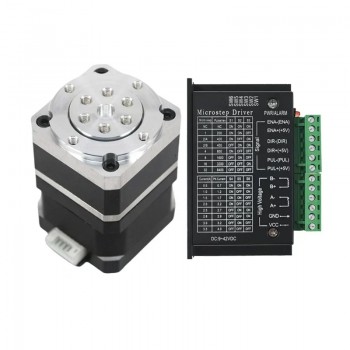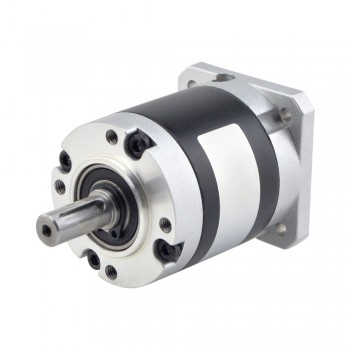1.Brief of harmonic reducer gearbox
A harmonic reducer gearbox, also known as a harmonic drive, uses the elastic deformation of a flexible gear (flexspline) to achieve high reduction ratios and precise motion control. It typically consists of three main components: a wave generator, a flexspline, and a circular spline. The wave generator, an elliptical component, deforms the flexspline, causing it to engage with the circular spline at two points. This engagement, combined with the difference in tooth count between the flexspline and circular spline, results in a significant reduction ratio.

2.Working principle of harmonic reducer gearbox.
1.The wave generator rotates, causing the flexspline to deform and engage with the circular spline at two diametrically opposed points.
2.As the wave generator continues to rotate, the points of engagement move around the circumference of the circular spline.
3.Because the flexspline has fewer teeth than the circular spline, each rotation of the wave generator results in a small relative rotation of the flexspline in the opposite direction.
4.This difference in tooth count and the controlled deformation of the flexspline create the high reduction ratio.
3.Importance of harmonic reducer gearbox
1.High Reduction Ratios: Harmonic drives can achieve significantly higher speed reduction ratios compared to traditional gear systems in the same space. This allows for smaller, lighter, and more efficient overall designs.
2.High Torque Capacity: Due to the large number of teeth in simultaneous contact and surface contact, harmonic drives can handle high torque loads effectively. This makes them suitable for demanding applications where high force or power transmission is needed.
3.High Precision and Accuracy: Harmonic drives are known for their low backlash and high repeatability, making them ideal for applications requiring precise positioning and motion control. This is critical in robotics, where accurate movements are essential.
4.Compact Size and Light Weight: The design of harmonic drives allows for a compact and lightweight construction, which is advantageous in space-constrained environments or when weight is a critical factor.
5.Smooth and Quiet Operation: The continuous engagement of teeth in harmonic drives results in smooth and quiet operation, minimizing vibrations and noise.
6.Versatility: Harmonic drives can be used for both speed reduction and speed increase, making them adaptable to various mechanical system requirements. They can also change the direction of torque transmission.
7.Applications: Harmonic drive gearboxes are widely used in a variety of industries, including:robotics,aerospace,medical devices,semiconductor manufacturing,and other applications(industrial automation, CNC machines, telescopes, and more).

4.Maintenance methods of harmonic reducer gearbox
1.Cleaning and inspection: Clean the harmonic reducer gearbox regularly. It is recommended to perform external cleaning at least once a month, use a soft cloth or compressed air to remove dust and debris, and avoid using corrosive chemicals. Regularly check the wear of gears, bearings and other moving parts.
2.Lubrication: Choosing the right lubricant is crucial to the performance of the harmonic reducer gearbox. The right lubricating oil or grease should be selected according to the manufacturer’s recommendations and the working environment. The lubricating oil should be checked and replaced every 1000 to 2000 hours of operation, and the grease should be replenished or replaced every 6 to 12 months.
3.Temperature control: Monitor the temperature of the harmonic reducer gearbox during operation. Excessive temperature will affect its performance and life. It is recommended to install a temperature sensor to monitor the temperature of the equipment in real time and ensure that there is enough space around it for heat dissipation. If the ambient temperature is high, you can consider adding a cooling fan or using a cooling system.
4.Load management: Avoid long-term overload and the load should be reasonably distributed according to the manufacturer’s specifications. Avoid sudden excessive torque during startup to reduce the impact on gears and bearings.
5.Electrical maintenance: Check the electrical connections regularly to ensure that there is no looseness or corrosion. For harmonic reducer gearboxes used outdoors, appropriate protective measures such as waterproof and dustproof covers should be taken to prevent damage to electrical components.
6.Fault diagnosis: If the harmonic reducer gearbox makes abnormal sounds or vibrations during operation, it should be stopped and checked immediately. Use vibration analysis tools to regularly detect the vibration of the equipment. Abnormal vibration may be a sign of damage to internal components.
7.Regular inspection and maintenance: Develop a detailed maintenance plan based on the equipment’s usage and the manufacturer’s recommendations, including a schedule for cleaning, lubrication, inspection, and replacement of parts.